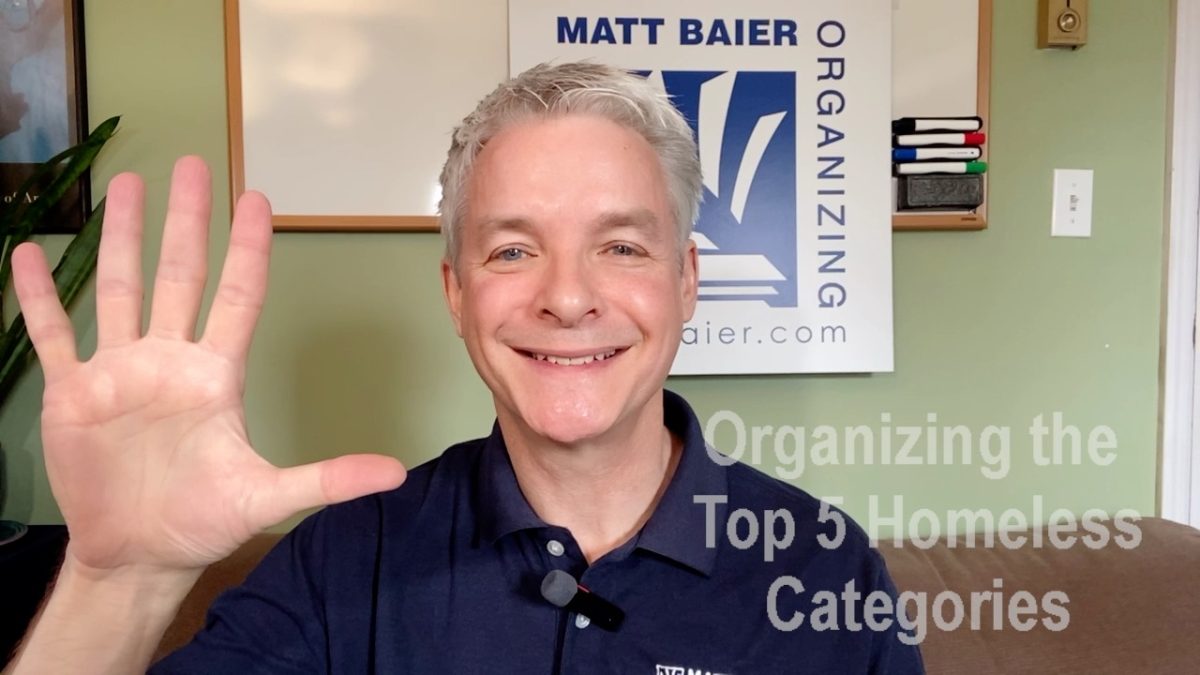I often say that organizing is ultimately not about sorting out your stuff, your paper, or your time. Rather, it’s about sorting out your priorities. Financial advisors have similar advise for managing your finances. Don’t look for that magic stock. Start by looking at what your financial priorities are. It’s essential in both cases. Why? Because everybody has different priorities AND because priorities are always changing.
Maybe this sounds obvious, but you might be surprised to learn how often folks don’t recognize their priorities. When a prospect contacts me, she may say that she wants help organizing her closets. I always push a little bit more for information, to determine her priority. What was the tipping point? What made you Google “closet organizing Connecticut?” She may share a story of running late to an appointment, because she was looking for something. She ended up having to buy this item, only to find it later.
At the consult, I see that the closet is so full, that even purging won’t get her organized. So I push a little further. I learn that the seasonal items are from an overloaded coat closet. The coat closet is overloaded from items that belong in the basement. The basement is full of items from her late parents, that she never uses. Although it’s not obvious, dealing with her parent’s low-priority stuff is a top priority. That’s because it directly affects her top-priority stuff.
So how do we recognize our top priorities and how do we manage them? Here are some tips.
1. Start from the end and work backwards
If you wait for priority management guidelines to come, you will wait until the day you die. So start there! Imagine you are on your death bed. What would be the things that you regret not doing? What are the things you would regret wasting time on? The big goals are overwhelming because they are big! However, they are always made up of a series of steps. Make the first one today. Wasting time searching in that closet every day? That adds up. Plan on opening space this winter.
2. Don’t limit priorities to your career
Various sources encourage us to plan and prioritize our professional goals. However, it is important to prioritize our personal goals too. Remember that they occupy the same 24 hour day, so they have to share.
3. Annual speed purge
I recently read an interesting insight from Harvard psychologist, Jerome Bruner. He said, “You’re more likely to act yourself into feeling than feely yourself into acton.” If you’re not getting a feeling for what your priorities are, try an annual speed purge. Choose a few clutter hot-spots in your home, particularly ones holding old projects and initiatives. Set a time for 30 minutes for each hot-spot and discard, donate and sell what you can. If you’re not sure, skip it. Just clear out the easy deadwood. The only priority this time is the “low hanging fruit.” For items you are not ready to discard, this is a great opportunity to reassess. This process reminds you of all the stuff you have and what your priorities have been. You may decide to do a more complete purge and prioritization in certain areas at a later time.
4. Trial purge
In addition to discard, donate, and sell, you might want to add “trial purge” to your choices. This is a sort of purgatory for items of questionable value (questionable priority). As I said, priorities are important to recognize, because they change. An item’s value changes with the changing priority. Maybe an item hasn’t completely lost all value, but it’s getting there. This is a trial purge candidate. Wherever you decide to store them, be sure the container is dated. It’s easy to lose track of time. When you know that you have been keeping an item for 3 years it is easer to discard it. It’s certainly easier than when you think you just bought it.
5. Project corrals
Priority management should always precede time management. Why? Because getting all your to-do’s to done might not feel like enough. If you keep putting off your big life goals, you still won’t feel like you have enough time. I manage priorities on a weekly basis with project corrals. I keep all ongoing projects and life projects together on an incline sorter of clear envelopes. I break each project up into a series of tasks. For each project there is a page of these tasks, each represented by a small post-it. That way, all projects are safely collected, but broken up into bite-sized pieces.
6. Weekly review
For the project corrals to work, you have to devote 15 minutes a week, to extract top-priority tasks. Don’t plan on more than 15 minutes or you won’t do it. Choose the tasks from these projects that meet your top priorities that week. Work them into your schedule between the fixed events and more immediate tasks of your week. That way you can blend the short-term with the long-term, in a realistic fashion. You’ll never find three free months to write a book. However, you may be able to fit in a 25 minute block, to “write first outline of book.” That’s a first step. Now do it. Then plan the next and you’re on your way.
New Years is a great opportunity to reevaluate priorities. i’m spending new year’s day doing an annual speed purge. It may sound strange, but I’m really looking forward to it! I see it as releasing sandbags, so that my hot-air balloon can climb higher. The hot-air balloon represents my top priorities for 2019. I see organizing as taking the less important things out of the way, so that you can get to your most important things. Those most important things are your priorities. They are released when you release the excess getting in the way.
Please Share With Your Community
















